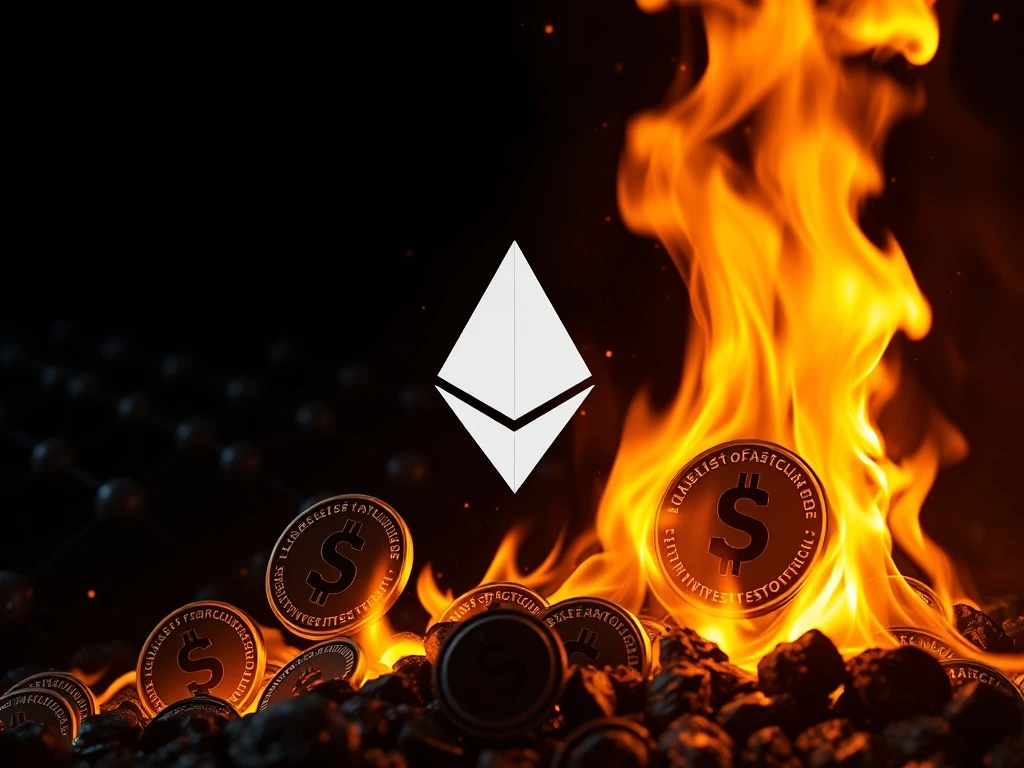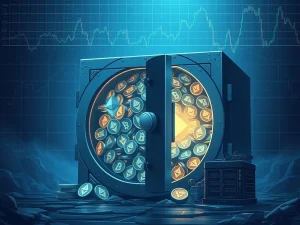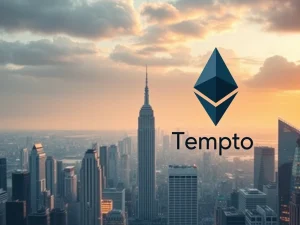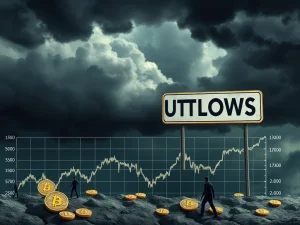Ethereum News Today: Crucial USDC Burns Safeguard USD Peg

In a significant move that underscores the continuous efforts to maintain stability in the volatile crypto market, Ethereum News Today highlights a remarkable event: over 104 million USDC tokens were strategically burned on the Ethereum blockchain within a mere 24 hours. This isn’t just a technical maneuver; it’s a crucial action designed to fortify USDC’s 1:1 USD Peg and ensure its reliability as a cornerstone of the decentralized finance (DeFi) ecosystem.
What Exactly is a USDC Burn and Why Does it Happen?
When we talk about a ‘token burn’ in the crypto world, it essentially means permanently removing tokens from circulation. Think of it like taking physical money out of the economy and shredding it – it reduces the total supply. For stablecoins like USDC, burns are primarily conducted in response to redemptions. When users convert their USDC back into traditional fiat currency (like USD), the corresponding USDC tokens are taken out of circulation to ensure the supply accurately reflects the reserves.
On July 25, 2025, the USDC Treasury executed two substantial burns on the Ethereum blockchain. An initial 50 million USDC (valued at $50.015 million) was removed, followed by another 55,000,025 USDC (valued at $54,986,842) later the same day. These combined actions removed a staggering 104.48 million USDC from circulation within just 24 hours. This transparent process, tracked by blockchain analytics platforms like Whale Alert, showcases the public verifiability of USDC’s supply management strategy. These operations align with routine redemption cycles, as stablecoin issuers like Circle adjust liquidity based on demand fluctuations [1, 2].
Why is Maintaining the USD Peg So Important for Crypto?
The core utility of any stablecoin, including USDC, lies in its promise to maintain a consistent 1:1 value with a fiat currency, in this case, the U.S. dollar. This USD Peg is not merely a theoretical concept; it’s the bedrock upon which much of the decentralized finance (DeFi) ecosystem is built. Stablecoins act as critical liquidity buffers, enabling seamless trading, lending, and borrowing without the extreme volatility inherent to other cryptocurrencies.
A stablecoin that loses its peg can trigger widespread panic, liquidity crises, and erode trust across the entire crypto landscape, as seen with past de-pegging events. By proactively managing its supply through burns, Circle aims to counteract potential inflationary pressures and ensure USDC remains a trustworthy and stable asset. Despite these significant burns, USDC’s price remained stable at $1.00, and its market cap held steady at $64.038 billion, demonstrating the effectiveness of these interventions [2].
How Does Ethereum News Today Show Its Strength in Stablecoin Management?
The recent USDC burn operations underscore Ethereum’s pivotal role as the leading blockchain infrastructure for large-scale stablecoin management. All these transactions—the burns and previous mints—are publicly recorded and verifiable on the Ethereum blockchain. This inherent transparency allows anyone to track the flow of USDC tokens, providing a crucial layer of trust and accountability that is often absent in traditional financial systems.
It’s this real-time verification capability that makes Ethereum an ideal backbone for managing the dynamic supply of a global stablecoin like USDC. The network’s robust infrastructure ensures these large-scale token adjustments are executed efficiently and securely, reinforcing confidence in USDC’s reserves, especially as stablecoins face heightened regulatory scrutiny.
Beyond Burns: The Dual Strategy of Stablecoin Management
Effective stablecoin management is a delicate dance between increasing and decreasing supply to match demand. It’s not just about burning tokens; it’s also about strategic minting. The USDC Treasury demonstrated this dynamic approach by minting 100 million USDC on Ethereum earlier in the same week [4]. This duality—reducing excess supply through burns while increasing issuance to meet new demand—ensures the stablecoin’s peg remains resilient even amid shifting market conditions.
This proactive and dynamic approach is vital for maintaining the token’s utility in both traditional and decentralized financial systems. Analysts note that such interventions can significantly shape investor perceptions, particularly in decentralized finance (DeFi) ecosystems where stablecoins serve as critical liquidity buffers [5].
How Do Crypto Liquidity and Broader Markets Connect to USDC?
While the recent USDC burns were primarily driven by operational adjustments related to redemptions, they occur within a broader, interconnected crypto ecosystem. The health of the stablecoin market is intrinsically linked to overall crypto liquidity and investor sentiment. For instance, strong inflows into spot Bitcoin and Ethereum ETFs, totaling $594 million around the time of these burns, indicate robust institutional interest and capital flowing into the crypto space [3].
Similarly, Ethereum’s price holding steady near $3,591 reflects ongoing confidence in the network that underpins USDC. It’s important to note that these USDC burns were driven by internal operational adjustments rather than external economic factors, such as the U.S. 10-year Treasury yield rising or mixed equity market performance [6]. This distinction highlights the independent nature of stablecoin supply management from broader macroeconomic trends, focusing instead on maintaining the integrity of the token itself.
The strategic USDC burn on Ethereum is a testament to the robust, transparent, and proactive approach required for effective stablecoin operation in today’s digital economy. These actions not only reinforce USDC’s critical 1:1 USD Peg but also highlight Ethereum’s indispensable role as the infrastructure enabling such large-scale, verifiable supply adjustments. As regulatory scrutiny on stablecoins intensifies globally, the transparency and proactive stablecoin management demonstrated by Circle and the USDC Treasury are paramount for building and maintaining trust, ensuring USDC continues to serve as a reliable bridge between traditional finance and the innovative world of decentralized applications.
Frequently Asked Questions (FAQs)
1. What is a USDC burn?
A USDC burn is the process of permanently removing USDC tokens from circulation. This is typically done when users redeem their USDC for fiat currency, ensuring that the total supply of USDC matches the underlying reserves held by its issuer, Circle.
2. Why are USDC tokens burned?
USDC tokens are burned primarily to maintain the stablecoin’s 1:1 peg with the U.S. dollar. By reducing the circulating supply when demand for redemptions occurs, it prevents an oversupply that could dilute the token’s value and cause it to de-peg.
3. How does the USDC burn affect its USD peg?
The USDC burn directly supports its USD peg by reducing the supply of tokens in circulation. This action helps to balance supply and demand, preventing the token’s value from falling below $1.00 due to excess supply. It’s a key mechanism for ensuring price stability.
4. Is the USDC burn transparent?
Yes, all USDC burn transactions occur on the Ethereum blockchain, which is a public and transparent ledger. Anyone can view these transactions using blockchain explorers, providing full visibility into the supply management operations of USDC.
5. What is the difference between minting and burning USDC?
Minting USDC involves creating new USDC tokens and introducing them into circulation, typically when new fiat currency is deposited. Burning USDC involves destroying existing tokens and removing them from circulation, usually when fiat currency is withdrawn. Both processes are essential for dynamic stablecoin management to maintain the 1:1 USD peg.










